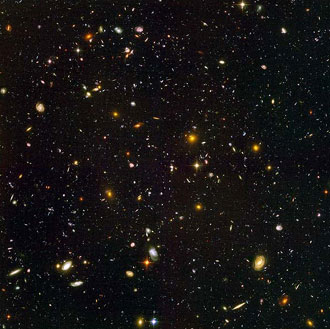Along time ago in a galaxy far, far away
Are you a 4H Astronomy Wannabe who also is an aficionado of fine literature? Attached is a short story written by John Updike titled The Acceleration Expansion of the Universe and printed in Harper's magazine October of 2004. It's pretty heavy duty but, boy!, that boy can write!

So we have a theory we call the Big Bang. It's a good scientific theory in that it explains all (or almost all) of the observed data and it makes predictions (Cosmic Background Radiation) that have been tested. It is also accepted by most Astronomers as most likely correct.
We should, then, be able to use our Big Bang theory to figure out how old the Universe is. Since we know the Universe is expanding we can "run the movie backwards" and figure out when everything makes a Gnab Gib (Big Bang backwards). The first time Edwin Hubble tried doing this his estimate was the Universe is a couple billion years old. Well this was a problem. There are rocks on Earth older than that! It isn't likely that the Earth is older than the Universe!
After much head scratching and many years of study, Astronomers came up with the notion that, in the very first fraction of a second of the Big Bang, the laws of Physics that we know now weren't "working" yet and nothing prevented the Universe from expanding quite large very, very quickly. This modification of the Big Bang theory is called the Inflationary Universe and is the current generally accepted explanation to the early Universe.
So then Astronomer could figure out just how old the Universe is, right? Well, not quite. While we knew that the Universe was expanding, it was VERY difficult to tell exactly how fast it was expanding. Astronomers could look at the spectra of a far distant galaxy and know how fast it was "moving" away from us from it's red-shift. But it was very far to tell just how far away the galaxy was. The Hubble Constant was the name given to the number that would tell us all. Here is the simple equation for H, the Hubble Constant: H= v/d. Simple, v is how fast (velocity) the distant galaxy is moving away from us and d is distance, how far away the galaxy is. We knew v, but didn't know d. We needed yet another "standard candle"!